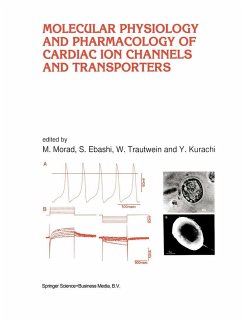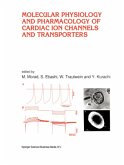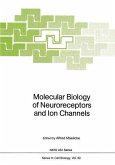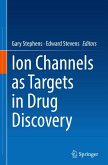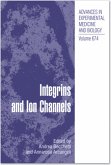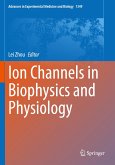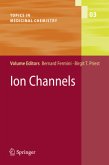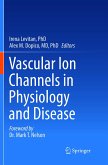M. Morad / S. Ebashi / W. Trautwein / Y. Kurachi (eds.)
Molecular Physiology and Pharmacology of Cardiac Ion Channels and Transporters
Herausgegeben:Morad, M.; Ebashi, S.; Trautwein, W.; Kurachi, Y.
M. Morad / S. Ebashi / W. Trautwein / Y. Kurachi (eds.)
Molecular Physiology and Pharmacology of Cardiac Ion Channels and Transporters
Herausgegeben:Morad, M.; Ebashi, S.; Trautwein, W.; Kurachi, Y.
- Gebundenes Buch
- Merkliste
- Auf die Merkliste
- Bewerten Bewerten
- Teilen
- Produkt teilen
- Produkterinnerung
- Produkterinnerung
Knowledge of cardiac ion channels and transporters has advanced remarkably in the last two decades with the development of patch-clamp and molecular biological techniques. This textbook offers a comprehensive overview of structures and functions of ion channels and transporters in the heart. Readers are first introduced to the molecular biology and electrophysiology of all the important ion channels. After discussing their developmental changes, the pharmacology and pathophysiology of clinically-relevant ion channels are reviewed. Molecular aspects of the cardiac excitation-contraction…mehr
Andere Kunden interessierten sich auch für
![Molecular Physiology and Pharmacology of Cardiac Ion Channels and Transporters Molecular Physiology and Pharmacology of Cardiac Ion Channels and Transporters]() Molecular Physiology and Pharmacology of Cardiac Ion Channels and Transporters249,99 €
Molecular Physiology and Pharmacology of Cardiac Ion Channels and Transporters249,99 €![Molecular Biology of Neuroreceptors and Ion Channels Molecular Biology of Neuroreceptors and Ion Channels]() Molecular Biology of Neuroreceptors and Ion Channels125,99 €
Molecular Biology of Neuroreceptors and Ion Channels125,99 €![Ion Channels as Targets in Drug Discovery Ion Channels as Targets in Drug Discovery]() Ion Channels as Targets in Drug Discovery147,99 €
Ion Channels as Targets in Drug Discovery147,99 €![Integrins and Ion Channels Integrins and Ion Channels]() Integrins and Ion Channels110,99 €
Integrins and Ion Channels110,99 €![Ion Channels in Biophysics and Physiology Ion Channels in Biophysics and Physiology]() Ion Channels in Biophysics and Physiology166,99 €
Ion Channels in Biophysics and Physiology166,99 €![Ion Channels Ion Channels]() Ion Channels147,99 €
Ion Channels147,99 €![Vascular Ion Channels in Physiology and Disease Vascular Ion Channels in Physiology and Disease]() Vascular Ion Channels in Physiology and Disease125,99 €
Vascular Ion Channels in Physiology and Disease125,99 €-
-
-
Knowledge of cardiac ion channels and transporters has advanced remarkably in the last two decades with the development of patch-clamp and molecular biological techniques. This textbook offers a comprehensive overview of structures and functions of ion channels and transporters in the heart. Readers are first introduced to the molecular biology and electrophysiology of all the important ion channels. After discussing their developmental changes, the pharmacology and pathophysiology of clinically-relevant ion channels are reviewed. Molecular aspects of the cardiac excitation-contraction coupling and intracellular Ca2+ regulation by ion transporters are also described. The book will be useful to electrophysiologists, cardiac physiologists and pharmacologists, and molecular biologists interested in ion channels at all levels. For research specialists, the book will provide a perspective of the field. The book can be used as a reference source for working scientists in the fields of ion channels, biophysics, cardiac electrophysiology, and pharmacology. It is aimed at graduate and medical students, designed for use as a textbook for graduate and medical courses.
Hinweis: Dieser Artikel kann nur an eine deutsche Lieferadresse ausgeliefert werden.
Hinweis: Dieser Artikel kann nur an eine deutsche Lieferadresse ausgeliefert werden.
Produktdetails
- Produktdetails
- Developments in Cardiovascular Medicine 182
- Verlag: Springer / Springer Netherlands
- Artikelnr. des Verlages: 978-0-7923-3913-7
- 1996.
- Seitenzahl: 628
- Erscheinungstermin: 31. August 1996
- Englisch
- Abmessung: 260mm x 183mm x 38mm
- Gewicht: 1406g
- ISBN-13: 9780792339137
- ISBN-10: 0792339134
- Artikelnr.: 22509844
- Herstellerkennzeichnung
- Books on Demand GmbH
- In de Tarpen 42
- 22848 Norderstedt
- info@bod.de
- 040 53433511
- Developments in Cardiovascular Medicine 182
- Verlag: Springer / Springer Netherlands
- Artikelnr. des Verlages: 978-0-7923-3913-7
- 1996.
- Seitenzahl: 628
- Erscheinungstermin: 31. August 1996
- Englisch
- Abmessung: 260mm x 183mm x 38mm
- Gewicht: 1406g
- ISBN-13: 9780792339137
- ISBN-10: 0792339134
- Artikelnr.: 22509844
- Herstellerkennzeichnung
- Books on Demand GmbH
- In de Tarpen 42
- 22848 Norderstedt
- info@bod.de
- 040 53433511
One.- Section I: Channels and channel proteins.- 1: Introduction.- 1. Overview: channels and channel proteins.- 2: A pacemaker channel.- 2. The hyperpolarization-activated inward channel and cardiac pacemaker activity.- 3. The hyperpolarization-activated (If) current: autonomic regulation and the control of pacing.- 3: The cardiac Na+ channel.- 4. Current understanding of the structure of the voltage gated sodium channel.- 5. ?-adrenergic regulation of cardiac Na+ channel.- 4: The L-type cardiac Ca2+ channel.- 6. L-type calcium channel structure and function.- 7. L-type Ca channel biophysics.- 8. ?-adrenergic and muscarinic regulation of L-type calcium current.- 9. Regulation of cardiac Ca2+ channels by cGMP and NO.- 5: The cardiac K+ channel.- 10. Diversity of voltage-dependent K channels.- 11. Cloned human heart delayed rectifier K+ channels.- 12. Primary structure and biophysical properties of inward rectifying K+ channel family.- 13. Ca2+-dependent transient outward current in mammalian heart.- 14. Delayed potassium channels in the heart: regulatory and molecular properties.- 15. Muscarinic and purinergic regulation of cardiac K+ channels.- 6: Cardiac Cl? channels.- 16. Chloride channels in heart.- 7: Cardiac ion channels not gated by voltage.- 17. Properties of cardiac ATP-sensitive potassium channels.- 18. Physiological and molecular properties of cardiac gap junctions.- 19.Volume-regulated cardiac ion channels.- 20. Regulation of cardiac activity by ATP, a purine agonist.- Section II: Ion channels in cardiovascular development.- 1.- 21. Developmental aspects of cardiac ion channels.- 22. Developmental changes and regulation of L-type calcium channels of myocardial cells and vascular smooth muscle cells.- Section III: Pharmacology of ion channels.- 1.- 23.Pharmacology of the calcium channel antagonists.- 24. Interactions of calcium antagonists and agonists with calcium channels in muscle cells.- 25. Pharmacological regulation of the cardiac ATP-sensitive K+ channel.- 26. Fatty acids and cardiac K+ channels.- 27. Sodium channels and block.- Section IV: Ion channels and cardiac pathology.- 1.- 28. Afterdepolarizations triggered rhythms and cardiac arrhythmias.- 29. Transient inward current and triggered activity.- 30. The Na+-activated K+ channel.- 31. Regulation of cardiac ATP-sensitive K channels during ischemia, hypoxia and impaired metabolism.- Two.- Section I: Molecular aspects of Ca2+ release.- 1.- 32. Signaling of calcium release in cardiac muscle.- 33. Local calcium transients in voltage-clamped cardiac cells: evoked 'calcium sparks'.- 34. Sarcoplasmic recticulum ryanodine receptor/Ca2+ release channel: a functional perspective.- 35. Molecular structure of calcium release channels.- Section II: Molecular steps in cardiac relaxation.- 1.- 36. Sarcoplasmic reticulum Ca2+ ATPases.- 37. Molecular structure and function of phospholamban.- 2: Molecular biology and physiology of Na+-Ca2+ exchange.- 38. Na+-Ca2+ exchanger: molecular aspects.- 39. Na/Ca exchanger: molecular and cellular characteristics.- 40. The functional significance of sodium-calcium exchange.- 41.The physiology of the Na-Ca exchange.- 3: Contraction-relaxation regulation.- 42. Regulation of cardiac relaxation.- 43. Evaluation of changes in myofibrillar Ca2+ sensitivity in intact cardiac cells.- 44. ?-Adrenergic receptor-dependent regulation of myocardial contractility.- 45. Ca transport from the cytoplasm and dynamic cellular Ca balance in cardiac myocytes.- Section III: Regulation of cellular Ca2+ by other transporters.- 1.- 46. Regulation ofintracellular protons: role of Na/H exchange in cardiac myocytes.- 2.- 47. Magnesium homeostasis and cardiac cell function.- 3.- 48. Na-K pump: multiple isoforms and their roles in cardiac functions.
One.- Section I: Channels and channel proteins.- 1: Introduction.- 1. Overview: channels and channel proteins.- 2: A pacemaker channel.- 2. The hyperpolarization-activated inward channel and cardiac pacemaker activity.- 3. The hyperpolarization-activated (If) current: autonomic regulation and the control of pacing.- 3: The cardiac Na+ channel.- 4. Current understanding of the structure of the voltage gated sodium channel.- 5. ?-adrenergic regulation of cardiac Na+ channel.- 4: The L-type cardiac Ca2+ channel.- 6. L-type calcium channel structure and function.- 7. L-type Ca channel biophysics.- 8. ?-adrenergic and muscarinic regulation of L-type calcium current.- 9. Regulation of cardiac Ca2+ channels by cGMP and NO.- 5: The cardiac K+ channel.- 10. Diversity of voltage-dependent K channels.- 11. Cloned human heart delayed rectifier K+ channels.- 12. Primary structure and biophysical properties of inward rectifying K+ channel family.- 13. Ca2+-dependent transient outward current in mammalian heart.- 14. Delayed potassium channels in the heart: regulatory and molecular properties.- 15. Muscarinic and purinergic regulation of cardiac K+ channels.- 6: Cardiac Cl? channels.- 16. Chloride channels in heart.- 7: Cardiac ion channels not gated by voltage.- 17. Properties of cardiac ATP-sensitive potassium channels.- 18. Physiological and molecular properties of cardiac gap junctions.- 19.Volume-regulated cardiac ion channels.- 20. Regulation of cardiac activity by ATP, a purine agonist.- Section II: Ion channels in cardiovascular development.- 1.- 21. Developmental aspects of cardiac ion channels.- 22. Developmental changes and regulation of L-type calcium channels of myocardial cells and vascular smooth muscle cells.- Section III: Pharmacology of ion channels.- 1.- 23.Pharmacology of the calcium channel antagonists.- 24. Interactions of calcium antagonists and agonists with calcium channels in muscle cells.- 25. Pharmacological regulation of the cardiac ATP-sensitive K+ channel.- 26. Fatty acids and cardiac K+ channels.- 27. Sodium channels and block.- Section IV: Ion channels and cardiac pathology.- 1.- 28. Afterdepolarizations triggered rhythms and cardiac arrhythmias.- 29. Transient inward current and triggered activity.- 30. The Na+-activated K+ channel.- 31. Regulation of cardiac ATP-sensitive K channels during ischemia, hypoxia and impaired metabolism.- Two.- Section I: Molecular aspects of Ca2+ release.- 1.- 32. Signaling of calcium release in cardiac muscle.- 33. Local calcium transients in voltage-clamped cardiac cells: evoked 'calcium sparks'.- 34. Sarcoplasmic recticulum ryanodine receptor/Ca2+ release channel: a functional perspective.- 35. Molecular structure of calcium release channels.- Section II: Molecular steps in cardiac relaxation.- 1.- 36. Sarcoplasmic reticulum Ca2+ ATPases.- 37. Molecular structure and function of phospholamban.- 2: Molecular biology and physiology of Na+-Ca2+ exchange.- 38. Na+-Ca2+ exchanger: molecular aspects.- 39. Na/Ca exchanger: molecular and cellular characteristics.- 40. The functional significance of sodium-calcium exchange.- 41.The physiology of the Na-Ca exchange.- 3: Contraction-relaxation regulation.- 42. Regulation of cardiac relaxation.- 43. Evaluation of changes in myofibrillar Ca2+ sensitivity in intact cardiac cells.- 44. ?-Adrenergic receptor-dependent regulation of myocardial contractility.- 45. Ca transport from the cytoplasm and dynamic cellular Ca balance in cardiac myocytes.- Section III: Regulation of cellular Ca2+ by other transporters.- 1.- 46. Regulation ofintracellular protons: role of Na/H exchange in cardiac myocytes.- 2.- 47. Magnesium homeostasis and cardiac cell function.- 3.- 48. Na-K pump: multiple isoforms and their roles in cardiac functions.

